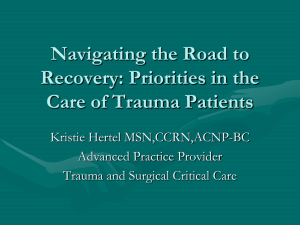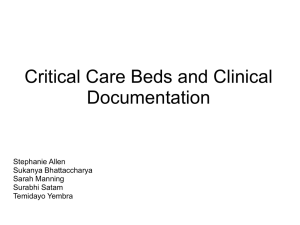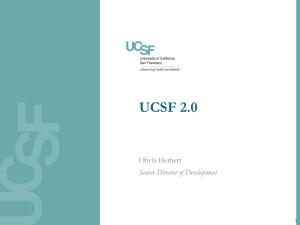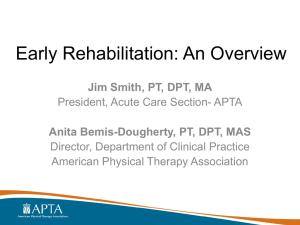ICU Early Mobilization at UCSF
advertisement
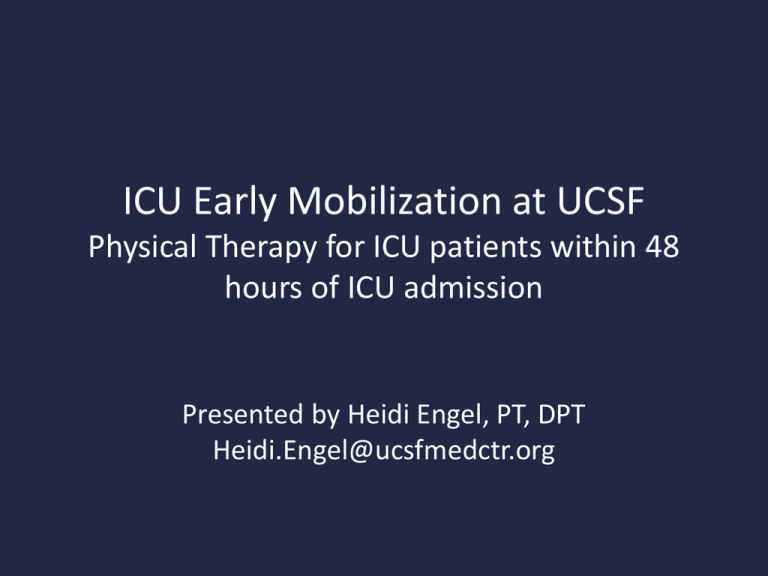
ICU Early Mobilization at UCSF Physical Therapy for ICU patients within 48 hours of ICU admission Presented by Heidi Engel, PT, DPT Heidi.Engel@ucsfmedctr.org Steps Taken at UCSF- 9 ICU • Research • Promotion • Role models – UCSF 10 ICU/ICC – Johns Hopkins Hospital – LDS Medical Center • Create multi-discipline team • Add staffing and equipment Research Schweickert WD, Pohlman MC, Pohlman AS, et al. Early physical and occupational therapy in mechanically ventilated, critically ill patients: a randomised controlled trial. Lancet. May 13 2009 • RCT- 104 patients on mechanical ventilation – intervention group- PT median of 1.5 days intubation – control groupPT median of 7.4 days – Intervention group- • less days of delirium and MV • 59% return to independent function at hospital discharge 35% in control group . Research Morris, P. E., L. Griffin, et al. (2011). "Receiving Early Mobility During an Intensive Care Unit Admission Is a Predictor of Improved Outcomes in Acute Respiratory Failure." Am J Med Sci. • Retrospective Survey of 280 Acute respiratory failure survivors • Factors associated with readmissions or death during the first year– Tracheostomy – Female gender – Higher Charlson Comorbidity Index – Lack of early ICU mobility Promotion • • • • • • • • • • Staff meeting in-services Visiting consultants RN Newsletter Critical care grand rounds CEO office hours E-mail updates Multi-discipline meetings Community bulletin board Sedation education Sleep and thirst studies Role Models- UCSF10 ICU/ICC • Mobilizing ECLS patients- centrally cannulated. Sternotomy with cannula in R atrium (inflow) to aorta (anastomosed). Both cannula tunneled out and connected to circuit. • ECLS patients regularly got out of bed and walked over to chair. Spent several hours per day out of bed. Adult ExtraCorporeal Life Support (ECLS) VV Cannulation via the Double Lumen Cannula Staffing and Equipment • UCSF- one full time PT added • No additional RN or RT staff • ICU platform walker, ear plugs, eye masks, seating cushions • PTs mobilize patients to higher level than RNs – Garzon-Serrano, J., C. Ryan, et al. (2011). "Early Mobilization in Critically Ill Patients: Patients' Mobilization Level Depends on Health Care Provider's Profession." PM R 3(4): 307-313. UCSF Exclusion Guidelines • Patients with immediate plans to transfer to outside hospital • Patients who require significant doses of vasopressors for hemodynamic stability (maintain MAP> 60) • Mechanically ventilated patients who require FiO2 .8 and/or PEEP >12, or have acutely worsening respiratory failure • Patients maintained on neuromuscular paralytics • Patients in an acute neurological event (CVA,SAH, ICH) with re-assessment for mobility every 24 hours • Patients unresponsive to verbal stimuli • Patients with unstable spine or extremity fractures • Patients with a grave prognosis- transferring to comfort care • Patients with a femoral dialysis catheter • Patients with open abdomen, at risk for dehiscence Barriers to Implementation- “It’s Not a Strength Issue.” • • • • • • • • • • Nervous or skeptical clinicians Minimal resources allocated Awkward equipment PT referrals still too late Unclear protocol PT in the ICU now a moderate priority rather than a last priority, but not a top priority Mobility prior to extubation is difficult concept for all Constantly rotating and changing personnel Variations in sedation practices New hospital and discharge course predictions required for ICU and floor personnel UCSF ICU- step 1, untangling UCSF ICU- step 2, bed exercise UCSF ICU- step 3, sitting on EOB UCSF ICU- step 4, assisted sit to stand UCSF ICU- step 5, walking UCSF ICU- step 6, sit and rest as needed Benefits to UCSF- ICU Early mobilization Patient lines and drains can be accommodated Benefits to UCSF- ICU Early mobilization Patient lines and drains can be accommodated Benefits to UCSF- ICU Early mobilization Less stress experienced by family and patients Benefits to UCSF- ICU Early Mobilization • Two planned tracheotomies avoided • Decreased length of stay • Patients able to go home instead of to SNF Benefits to UCSF- ICU Early Mobilization 13 ICU- standard PT care • 51 yo M ARDS pt, I community level activity • 50mcg propofol PEEP 8 FiO2 .6 • Bed rest activity orders, PT referral on HD 10 • Failed SBT, delirium • LOS 1 month, 5 sessions PT • d/c’d to acute care able to stand 30 seconds with minA of 2 9 ICU- early mobilization • 25 yo F ARDS pt, I community level activity • 100mcg propofol PEEP 16 FiO2 .9 • Activity as tolerated orders, PT referral on HD 1 • ICUAW, tracheotomy • LOS 1 month, 19 sessions PT • d/c’d to acute rehab able to walk SBA FWW 60’ X4 ICU Patients Receiving Physical Therapy Variables 3/2009- 12/2009 Pre-ICU Early Mob 3/2010- 12/2010 Post-ICU Early Mob # of PT patients, Average # PT visits 220 patients, 5 visits 33 patients intubated 397 patients, 5 visits 53 intubated Assist level scores Min A on average Mod A on average overall # of PT patients in ICU walking 77 patients walking 148 patients walking Average distance walked 87 feet 147 feet Average length of hospital stay 24 days 10 days in ICU 19 days 8 days in ICU % of PT patients walking 55% d/c from UCSF to in ICU d/c to home home 71% d/c from UCSF to home UCSF Experience of ICU Early Mobilization Improvements in discharge outcome correlate to • Earlier mobility • More intense intervention • Greater distance walked Future for ICU Early Mobilization at UCSF • Questions to answer – Are we comfortable with mobilizing patients on vasopresssors, with femoral lines, with agitation? – How do we coordinate ventilation, sedation, spontaneous breathing trials, and extubation with mobilization? – How do we take into account functional mobility, endurance, and physiologic reserve of the patient? Surgical Optimal Mobility Score (SOMS) • 113 patients studied in a single center prospective cohort – Roughly ½ patients on pressors, 1/3 on mechanical ventilators • SOMS assessed by RNs day 1 of ICU admission to SICU independently predicted – In hospital mortality – SICU and total hospital length of stay • Kasotakis G, Schmidt U, Perry D, Grosse-Sundrup M, Benjamin J, Ryan C, et al. The surgical intensive care unit optimal mobility score predicts mortality and length of stay. Crit Care Med. 2011. Mobility Information Treatment Number vs. Mobility Score 5 Mobility Score 4 3 2 Series1 Poly. (Series1) 1 0 Eval Treatment Number Mobility Information Treatment Number vs. Mobility Score 5 4 Series1 Poly. (Series1) Mobility Score 3 2 1 0 Eval -1 Treatment Number ICU Early Mobilization Improves patient satisfaction and outcomes The Ounce of Prevention Reward Thank You • UCSF Critical Care- Michael Gropper, MD, Michael Matthay, MD, Kevin Thornton, MD • UCSF Executive Director for Service Lines- Karen Rago, RN, MPA, FAAMA, FACCA • UCSF Nursing- Steve Koster, RN, Charlotte Garwood, RN, Sarah Irvine, RN, Hildy Schell-Chaple, CNS, Cathy Schuster, RN • UCSF Critical Care Nurse Practitioners- Geoffrey Latham, NP, Maureen Mary Arriola, NP, Tom Farley, NP • UCSF Respiratory Therapy- Brian Daniel, RT • UCSF Rehabilitative Services- Joy Devins, PT, Rebecca Mustille, PT, Shin Tatebe, PT, Sherri Heft, PT, Phil Alonzo, • Johns Hopkins Hospital ICU PM&R- Dale Needham, MD, Eddy Fan, MD • LDS Medical Center- Polly Bailey, NP, Louise Bezdjian, NP • Photo Credits- Jim Jocoy, PTA




